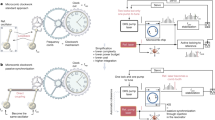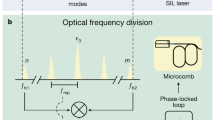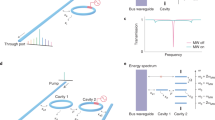Abstract
The generation of spectrally pure microwave signals is a critical functionality in fundamental and applied sciences, including metrology and communications. Optical frequency combs enable the powerful technique of optical frequency division (OFD) to produce microwave oscillations of the highest quality1,2. Current implementations of OFD require multiple lasers, with space- and energy-consuming optical stabilization and electronic feedback components, resulting in device footprints incompatible with integration into a compact and robust photonic platform3,4,5. Here we demonstrate all-optical OFD on a photonic chip by synchronizing two distinct dynamical states of Kerr microresonators pumped by a single continuous-wave laser. The inherent stability of the terahertz beat frequency between the signal and idler fields of an optical parametric oscillator is transferred to a microwave frequency of a Kerr soliton comb, and synchronization is achieved via a coupling waveguide without the need for electronic locking. OFD factors of N = 34 and 468 are achieved for 227 GHz and 16 GHz soliton combs, respectively. In particular, OFD enables a 46 dB phase-noise reduction for the 16 GHz soliton comb, resulting in the lowest microwave noise observed in an integrated photonics platform. Our work represents a simple, effective approach for performing OFD and provides a pathway towards chip-scale devices that can generate microwave frequencies comparable to the purest tones produced in metrological laboratories.
This is a preview of subscription content, access via your institution
Access options
Access Nature and 54 other Nature Portfolio journals
Get Nature+, our best-value online-access subscription
$29.99 / 30 days
cancel any time
Subscribe to this journal
Receive 51 print issues and online access
$199.00 per year
only $3.90 per issue
Buy this article
- Purchase on Springer Link
- Instant access to full article PDF
Prices may be subject to local taxes which are calculated during checkout




Similar content being viewed by others
Data availability
All data used in this paper is available in the Zenodo repository at https://zenodo.org/records/10652056.
Code availability
The code used to plot the data is available in the Zenodo repository. Simulation code may be obtained from the authors upon reasonable request.
References
Ludlow, A. D., Boyd, M. M., Ye, J., Peik, E. & Schmidt, P. O. Optical atomic clocks. Rev. Mod. Phys. 87, 637–701 (2015).
Bothwell, T. et al. JILA SrI optical lattice clock with uncertainty of 2.0 × 10−18. Metrologia 56, 065004 (2019).
Fortier, T. M. et al. Generation of ultrastable microwaves via optical frequency division. Nat. Photon. 5, 425–429 (2011).
Li, J., Yi, X., Lee, H., Diddams, S. A. & Vahala, K. J. Electro-optical frequency division and stable microwave synthesis. Science 345, 309–313 (2014).
Tetsumoto, T. et al. Optically referenced 300 GHz millimetre-wave oscillator. Nat. Photon. 15, 516–522 (2021).
Ivanov, E. N., Tobar, M. E. & Woode, R. A. Ultra-low-noise microwave oscillator with advanced phase noise suppression system. IEEE Microw. Guided W. 6, 312–314 (1996).
Kinget, P. in Analog Circuit Design (eds Sansen, W., Juijsign, J. & van de Plassche, R.) 353–381 (Springer, 1999).
Razavi, B. Design of millimeter-wave CMOS radios: a tutorial. IEEE Trans. Circuits Syst. 56, 4–16 (2009).
Rappaport, T. S., Murdock, J. N. & Gutierrez, F. State of the art in 60-GHz integrated circuits and systems for wireless communications. Proc. IEEE 99, 1390–1436 (2011).
van Beek, J. T. M. & Puers, R. A review of MEMS oscillators for frequency reference and timing applications. J. Micromech. Microeng. 22, 013001 (2011).
Madjar, A. & Berceli, T. Microwave generation by optical techniques - a review. In Proc. Eur. Microw. Conf. (eds. Brazil, T. & Walker, J.) 1099–1102 (Horizon House Publications Ltd, 2006).
Maleki, L. The optoelectronic oscillator. Nat. Photon. 5, 728–730 (2011).
Pikovsky, A., Rosenblum, M. & Kurths, J. Synchronization - A Universal Concept in Nonlinear Sciences, Vol. 12 (Cambridge Univ. Press, 2001).
Jang, J. K. et al. Observation of Arnold tongues in coupled soliton Kerr frequency combs. Phys. Rev. Lett. 123, 153901 (2019).
Rodrigues, C. C. et al. Optomechanical synchronization across multi-octave frequency spans. Nat. Commun. 12, 5625 (2021).
Weng, W., Kaszubowska-Anandarajah, A., Liu, J., Anandarajah, P. M. & Kippenberg, T. J. Frequency division using a soliton-injected semiconductor gain-switched frequency comb. Sci. Adv. 6, eaba2807 (2020).
Matsko, A. B. & Maleki, L. Noise conversion in Kerr comb RF photonic oscillators. J. Opt. Soc. Am. B 32, 232–240 (2015).
Yi, X. et al. Single-mode dispersive waves and soliton microcomb dynamics. Nat. Commun. 8, 3 (2017).
Bao, C. et al. Soliton repetition rate in a silicon-nitride microresonator. Opt. Lett. 42, 759–762 (2017).
Yang, Qi-Fan et al. Dispersive-wave induced noise limits in miniature soliton microwave sources. Nat. Commun. 12, 1442 (2021).
Drake, T. E., Stone, J. R., Briles, T. C. & Papp, S. B. Thermal decoherence and laser cooling of Kerr microresonator solitons. Nat. Photon. 14, 480–485 (2020).
Liu, F., Menyuk, C. R. & Chembo, Y. K. A stochastic approach to phase noise analysis for microwaves generated with Kerr optical frequency combs. Commun. Phys. 6, 117 (2023).
Coillet, Aurélien & Chembo, Y. On the robustness of phase locking in Kerr optical frequency combs. Opt. Lett. 39, 1529–1532 (2014).
Jang, J. K. et al. Synchronization of coupled optical microresonators. Nat. Photon. 12, 688–693 (2018).
Kim, BokYoung et al. Synchronization of nonsolitonic Kerr combs. Sci. Adv. 7, eabi4362 (2021).
Chembo, Y. K. & Yu, N. Modal expansion approach to optical-frequency-comb generation with monolithic whispering-gallery-mode resonators. Phys. Rev. A 82, 033801 (2010).
Coen, Stéphane & Erkintalo, M. Universal scaling laws of Kerr frequency combs. Opt. Lett. 38, 1790–1792 (2013).
Godey, C., Balakireva, I. V., Coillet, Aurélien & Chembo, Y. K. Stability analysis of the spatiotemporal lugiato-lefever model for kerr optical frequency combs in the anomalous and normal dispersion regimes. Phys. Rev. A 89, 063814 (2014).
Kwon, D. et al. Reference-free, high-resolution measurement method of timing jitter spectra of optical frequency combs. Sci. Rep. 7, 1–9 (2017).
Tian, H. et al. Optical frequency comb noise spectra analysis using an asymmetric fiber delay line interferometer. Opt. Express 28, 9232–9243 (2020).
Gorodetksy, M. L., Schliesser, A., Anetsberger, G., Deleglise, S. & Kippenberg, T. J. Determination of the vacuum optomechanical coupling rate using frequency noise calibration. Opt. Express 18, 23236–23246 (2010).
Huang, G. et al. Thermorefractive noise in silicon-nitride microresonators. Phys. Rev. A 99, 061801 (2019).
Joshi, C. et al. Thermally controlled comb generation and soliton modelocking in microresonators. Opt. Lett. 41, 2565–2568 (2016).
Liu, J. et al. Photonic microwave generation in the X- and K-band using integrated soliton microcombs. Nat. Photon. 14, 486–491 (2020).
Yariv, A. Critical coupling and its control in optical waveguide-ring resonator systems. IEEE Photonics Technol. Lett. 14, 483–485 (2002).
Zhao, Y., McNulty, K. J., Lipson, M. & Gaeta, A. L. Active tuning of the microresonator coupling condition with coupled rings. In Conference on Lasers and Electro-Optics (eds. Gan, Q., Saraceno, C., Da Ros, F. & Vasilyev, S.) SW4L.8 (Optica Publishing Group, 2023).
Liang, W. et al. High spectral purity Kerr frequency comb radio frequency photonic oscillator. Nat. Commun. 6, 7957 (2015).
Weng, W. et al. Coherent terahertz-to-microwave link using electro-optic-modulated Turing rolls. Phys. Rev. A 104, 023511 (2021).
Guha, B., Cardenas, J. & Lipson, M. Athermal silicon microring resonators with titanium oxide cladding. Opt. Express 21, 26557–26563 (2013).
Djordjevic, S. S. et al. CMOS-compatible, athermal silicon ring modulators clad with titanium dioxide. Opt. Express 21, 13958–13968 (2013).
Rodrigues, J. R. et al. SiN-based waveguides with ultra-low thermo-optic effect. In Conference on Lasers and Electro-Optics (eds. Prasankumar, R., Tanabe, T., Brès, C. S. & Paiella, R.) SM4G.3 (Optica Publishing Group, 2022).
Raghunathan, V. et al. Athermal operation of silicon waveguides: spectral, second order and footprint dependencies. Opt. Express 18, 17631–17639 (2010).
Kalubovilage, M., Endo, M. & Schibli, T. R. Ultra-low phase noise microwave generation with a free-running monolithic femtosecond laser. Opt. Express 28, 25400–25409 (2020).
Kalubovilage, M., Endo, M. & Schibli, T. R. X-Band photonic microwaves with phase noise below -180 dBc/Hz using a free-running monolithic comb. Opt. Express 30, 11266–11274 (2022).
Xie, X. et al. Photonic microwave signals with zeptosecond-level absolute timing noise. Nat. Photon. 11, 44–47 (2017).
Li, J. & Vahala, K. Small-sized, ultra-low phase noise photonic microwave oscillators at X-Ka bands. Optica 10, 33–34 (2023).
Jang, J. K. et al. Conversion efficiency of soliton Kerr combs. Opt. Lett. 46, 3657–3660 (2021).
Kondratiev, N., Lobanov, V., Dmitriev, N., Cordette, S. & Bilenko, I. Analysis of parameter combinations for optimal soliton microcomb generation efficiency in a simple single-cavity scheme. Phys. Rev. A 107, 063508 (2023).
Sun, S. et al. Integrated optical frequency division for microwave and mmwave generation. Nature https://doi.org/10.1038/s41586-024-07057-0 (2024).
Acknowledgements
This work was performed in part at the Cornell Nano-Scale Facility, which is a member of the National Nanotechnology Infrastructure Network, supported by the NSF and in part at the CUNY Advanced Science Research Center NanoFabrication Facility. We acknowledge computing resources from Columbia University’s Shared Research Computing Facility project, which is supported by NIH Research Facility Improvement Grant 1G20RR030893-01 and associated funds from the New York State Empire State Development, Division of Science Technology and Innovation (NYSTAR) Contract C090171, both awarded 15 April 2010. We thank T. Schibli, Y. Levin, K. Bergman and M. Hattink for helpful discussions. This work was supported by Defense Advanced Research Projects Agency of the US Department of Defense (Grant No. HR0011-22-2-0007), Army Research Office (ARO) (Grant No. W911NF-21-1-0286) and Air Force Office of Scientific Research (AFOSR) (Grant No. FA9550-20-1-0297).
Author information
Authors and Affiliations
Contributions
Y.Z., Y.O. and A.L.G conceived the project. Y.Z. and J.K.J. performed the theoretical analysis. Y.Z., J.K.J. and G.J.B. performed the experiment. Y.Z., J.K.J., Y.O. and A.L.G. performed the data analysis with input from all authors. X.J. and K.J.M. fabricated the silicon-nitride devices under the supervision of M.L. Y.Z., J.K.J. and A.L.G. wrote the manuscript with feedback from all authors. M.L. and A.L.G. supervised the project.
Corresponding author
Ethics declarations
Competing interests
The authors declare no competing interests.
Peer review
Peer review information
Nature thanks Olivier Llopis, Florian Sedlmeir and the other, anonymous, reviewer(s) for their contribution to the peer review of this work.
Additional information
Publisher’s note Springer Nature remains neutral with regard to jurisdictional claims in published maps and institutional affiliations.
Extended data figures and tables
Extended Data Fig. 1 Thermal noise characterization.
(a), Homodyne setup for thermal noise characterization of microresonators. DUT, device under test. (b), Measured thermal noise of the SiN device at room temperature (0V) and when a heating voltage is applied using a commercial arbitrary-waveform generator (1.3 V).
Extended Data Fig. 2 Experiment setup for 16-GHz microwave generation and characterization.
EDFA, erbium-doped fibre amplifier; WDM, wavelength division multiplexer. Two near-identical spiral resonators are used for OPO and soliton-comb generation, respectively. The output of the OPO chip is combined with the pump for the soliton chip via a fibre-based WDM to facilitate synchronization.
Supplementary information
Supplementary Information
Supplementary Figs. 1–3 and sections I–IV regarding theoretical model and numerical simulations: I, Schawlow–Townes linewidth of optical parametric oscillator; II, Classical phase-noise sources of optical parametric oscillator; III, Numerical model of synchronization; IV, Design example of the athermal waveguide.
Rights and permissions
Springer Nature or its licensor (e.g. a society or other partner) holds exclusive rights to this article under a publishing agreement with the author(s) or other rightsholder(s); author self-archiving of the accepted manuscript version of this article is solely governed by the terms of such publishing agreement and applicable law.
About this article
Cite this article
Zhao, Y., Jang, J.K., Beals, G.J. et al. All-optical frequency division on-chip using a single laser. Nature 627, 546–552 (2024). https://doi.org/10.1038/s41586-024-07136-2
Received:
Accepted:
Published:
Issue Date:
DOI: https://doi.org/10.1038/s41586-024-07136-2
This article is cited by
Comments
By submitting a comment you agree to abide by our Terms and Community Guidelines. If you find something abusive or that does not comply with our terms or guidelines please flag it as inappropriate.



